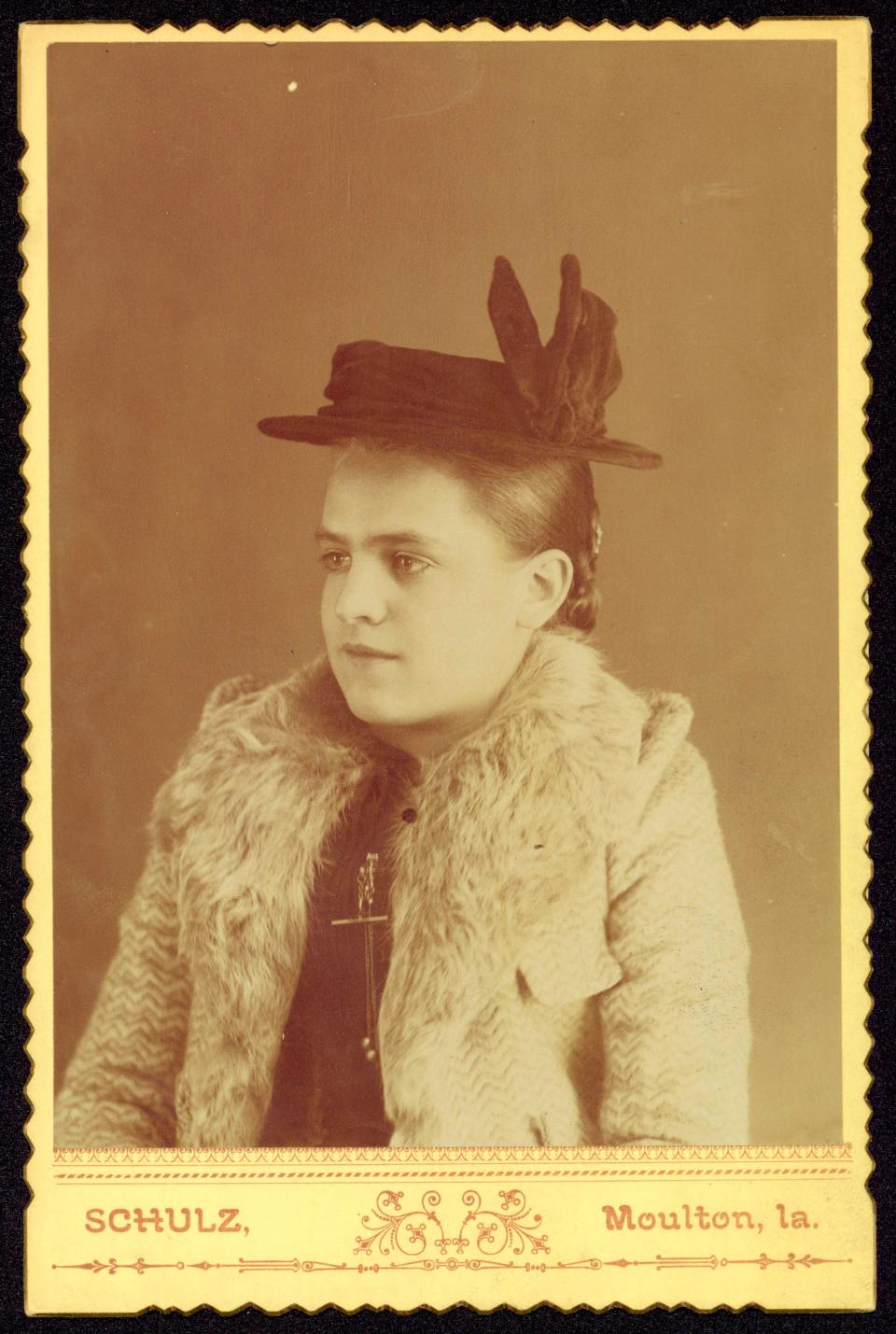Iowa History Month: Moulton’s Nellie V. Walker’s remarkable life on ladders
Nellie Verne Walker (1874-1973) was born at Red Oak in southwest Iowa and grew up in Moulton in Appanoose County. Fully grown at 4-foot-10 and weighing less than 100 pounds, Walker spent her life on ladders, creating classically beautiful sculptures — some larger than life.
Walker’s size never stopped her from working at scale. She is frequently noted as one of the outstanding women sculptors in America. In an interview, she commented: “I like all the various things we do — portraits, monuments, fountains, reliefs, everything. But I do like them large rather than small.”
Walker, the eldest of six children, observed her father, Everett Ami Walker, at work as a gravestone carver. As a teenager, she wished to use a block of limestone for carving a bust of President Abraham Lincoln. Popular journalist Luella Riley Spencer wrote: “The thrifty soul of the father was loth to have a fine pedestal ruined to satisfy a girlish whim. When she asked if she might have it to make into a bust of Lincoln, he flatly refused.”

After repeated requests, her father relented and allowed Walker to carve the stone. She spent 24 days sculpting the bust, which was exhibited as “The Work of an Iowa Girl” at the 1893 World’s Columbian Exposition in Chicago. Following the exposition, Walker’s parents displayed the bust at their home on North Main Street in Moulton and it is now at the Garrett Memorial Library there.
With her talent for art evident, Walker took a position as a secretary in Ottumwa. For six years, she worked that job while saving money to move to Chicago. In the early 1900s, it was uncommon for a single woman to seek success as a professional artist.
As referenced by Spencer:
“And even as late as the closing years of the nineteenth century, it was not the custom of young girls to go out from home to seek their fortunes. It was only the exceptional girl whose courage and ambition were great enough to push her out from the beaten path. Nellie V. Walker proved to be such a girl. On the first day of the twentieth century, poor and unknown, she went to Chicago to work out her career as a sculptor.”
Walker arrived in Chicago and began working with internationally-known sculptor Lorado Taft. It was seven years after her arrival that she received her first commission and found success as a sculptor. Walker’s tenacity, no doubt honed as the oldest child in a large family in rural Iowa, helped her work her way to success. For decades, Walker worked with Taft at Midway Studios and the Art Institute of Chicago. She was active in Chicago’s artistic and literary communities.
Throughout her career, Walker created both public and private monuments. The vast majority of her work is concentrated in the middle of the nation, save for a few pieces in Maryland and the Rocky Mountain West.
At least six sculptures by Walker, including her first sculpture at Moulton, remain in Iowa.
Her bronze statue of Sauk Chief Keokuk was installed at Rand Park in the city that bears his name. Taft specifically mentioned this sculpture in his groundbreaking publication, "The History of American Sculpture," published in 1903. He cited Walker as a significant young sculptor. Throughout her life, she created acclaimed work, mastered her craft and continued to justify Taft’s accolades.
William Fletcher King, who served as Cornell College President for 45 years, is memorialized with a stone bust on campus in Mount Vernon. Walker's other academic work is two bas relief panels at the Parks Library at Iowa State University in Ames.
Visitors to the state Capitol in Des Moines will see Walker’s “Iowa Suffrage Memorial” on the second floor near the Secretary of State’s Office.
And finally, Walker’s heroic-scale statue of U.S. Sen. James Harlan is in Mount Pleasant. The sculpture was originally installed at the U.S. Capitol as one of Iowa’s two contributions to National Statuary Hall. In 2014, the Harlan statue was replaced by a statue of Norman Borlaug. The Harlan figure was brought home to Iowa and installed on the campus of Iowa Wesleyan University, where Harlan served as president from 1853-1855.
Walker worked in the Beaux Arts style, which fell out of favor as modernism gained in popularity. She sculpted in Chicago until 1948, when Midway Studios was given to the University of Chicago. At that time, she reluctantly relocated to Colorado Springs to live with her widowed younger sister. Walker remained active in the sculpture community, modeling and working at Van Briggle Pottery. Sadly, failing eyesight forced her into retirement. Walker resided in Colorado Springs until her death at age 98. She was buried at Moulton.
Walker, who had been a member of the National Sculpture Society, was inducted into the Iowa Women’s Hall of Fame in 1987, and the work of her hands continues to stand the test of time across the state and beyond.
Jessica Rundlett is the Special Projects & Outreach coordinator for the State Historical Society of Iowa, which provided this essay as part of a series for Iowa History Month. For more information, visit iowaculture.gov.
March is Iowa History Month
To celebrate Iowa History Month, the Register has published weekly essays from leading state historians.
This article originally appeared on Des Moines Register: Iowa History Month: Nellie V. Walker’s remarkable life on ladders

